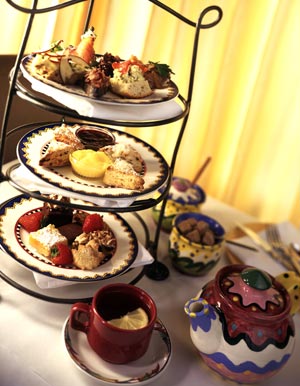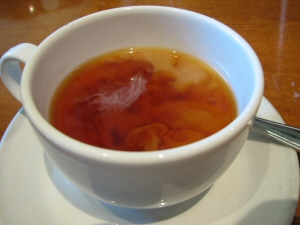Food and Drink
1. Meals
Breakfast, Elevenses, Lunch, Afternoon tea, High tea, Dinner, Supper
2.
Most popular foods in
National Food... see @ England, Northern Ireland, Scotland and Wales
3. Drinking Tea
5.
Pubs
Some people
have their biggest meal in
the middle of the day
but most have it in
the evening,
eating a small
mid-day meal - usually sandwiches, and perhaps some
crisps and some fruit.
Most people in Britain have three meals a day:
Breakfast - between
7:00 and 9:00,
Lunch - between 12:00 and 1:30 pm
Dinner (sometimes called Supper) - The main meal. Eaten anytime between 6:30 and 8:00 pm (Evening meal)
Traditionally, and
for some people still, the meals
are called:
Breakfast - between
7:00 and 9:00,
Dinner (If it is the main meal) - between
12:00 and 1:30 pm
Tea - anywhere from 5:30 at night to 6:30 pm
The traditional
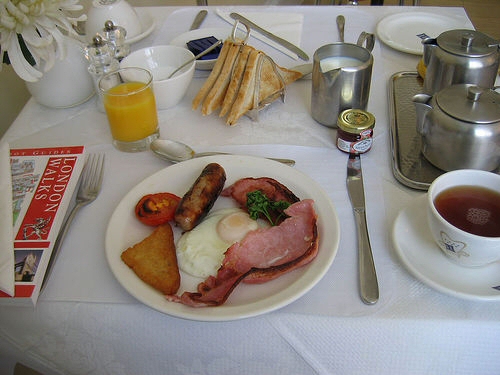
England: The full
English breakfast also includes tomatoes, beans, mushrooms, and black pudding. These are served with toast or crumpets.
Alternatively, fish can be served with bread and butter
and often scrambled eggs. Eating a full English breakfast daily is, however,
now rare, and most opt for cold breakfast cereal or toast, which is usually
eaten with marmalade. Grapefruit halves are commonly served. In the winter many
people will eat "porridge" or boiled oats.
In the
Employers and schools usually
give a lunch break in the middle of the day,
lasting about an hour. Some workplaces and schools provide cafeterias where
one can get a hot meal (In British schools staff
who serve lunch are often known as 'dinner ladies', but never
'lunch ladies'). If there is no cafereria or restaurant available, people
often pack their lunch and take it along in a lunchbox, or a container take.
Afternoon tea (The
traditional 4 o'clock tea)
This is a small meal, not a drink. Traditionally it consists of Tea (or coffee)
served with either of the following:
§ Freshly baked scones served with cream and jam (Known as a cream tea)
§ Afternoon 'tea sandwiches' often thinly sliced cucumber sandwiches with the crusts cut off.
§ Different pastries
For the middle class
population
|
Tea can mean the afternoon/evening meal, so called even if the diners are drinking beer, cider, or juice. It traditionally takes place at sometime around 6pm (though these days, it often takes place as late as 9pm). |
It would usually
consist of cold meats, toast, eggs and/or fish, cakes, and sandwiches, all
served at the same time. In a family, it tends to be less formal and often it is essentially
either a snack (usually featuring sandwiches, cookies, pastry, fruit) or else it is supper. In the
working class,
on farms for
example,
high tea is the traditional and very substantial meal enjoyed by the workers
immediately after dark, and combines afternoon tea with the main evening meal.
|
Having toured London all day with little more than a sandwich and a drink since breakfast, my friend and I, both students with a meager budget, were really looking forward to dinner at the home of our host. A kind, but rather conservative elderly lady, she received us with the news that a nice couple from church had heard about us and invited us over for tea. We were desperate for food by that time, but had no other choice than to wait for half seven and hope to eat something there. Since dinner was the only substantial meal in the lady's home, we hoped that tea would not be less than a cold version of a dinner - with tea, of course. (Our host obviously seemed to think likewise, not offering us anything in the meantime.) When we arrived it was clear from the setting that our lady was mistaken and that we were doomed to die a slow death of hunger. The couple only had tea, milk and sugar with some dry biscuits on the table for us. Since we were total strangers to we had to contend with that. Upon return, however, we could not keep quiet about our "culture shock", and begged our lady for a sandwich. She looked puzzled, mumbled something about how tea means different things to different people, and readily gave us something to save the day. |
Dinner traditionally meant the main meal of the day. Because of differences in custom as to when this meal was taken, dinner
might mean the
evening meal
(typically in the higher social classes) or the midday meal (typically in lower
social classes, who may describe their evening meal as tea). Large formal evening
meals are always described as dinners. School dinners is
a British phrase for school lunches. Misunderstanding is
often avoided by using lunch for the midday meal and tea or supper
for the evening meal, though these terms can also carry their own ambiguities. A more formal definition of 'dinner', especially
outside
Supper is the
evening meal - ordinarily the last meal of the day. In the
 Britain
Britain
The best-known
British dish eaten at home has been roast beef, traditionally eaten on
Sunday. Roast beef is served with roast potatoes, vegetables and gravy - a sauce made
from meat juices and stock, thickened with flour. Yorkshire pudding - batter
baked in hot fat in the oven - is a favourite accompaniment to roast beef.![]()
Everything in
|
|
Gradually, tea-drinking developed into a fashionable social ritual and
tea gardens blossomed in places like Vauxhall and Marylebone in
Tea in
The British generally pay a lot of attention to good table manners. Even young children are expected to eat properly with knife and fork. Exceptions include sandwiches, crisps, corn on the cob, and fruit.
Things you should do:
§
If you are a guest, it is polite to wait until your host(ess) starts eating or indicates you should do so. It shows
consideration.
§
Always chew and swallow all the food in your mouth before taking more or
taking a drink.
§
You may eat chicken and pizza with your fingers if you are at a
barbecue, finger buffet or very informal setting. Otherwise always use a knife
and fork.
§
Always say thank you when served something. It shows appreciation.
§
When eating rolls, break off a piece of bread before
buttering. Eating it whole looks
tacky.
§
When eating soup, tip the bowl away from you and scoop the soup up with
your spoon.
§
When you have finished eating, and to let others know that you have,
place your knife and folk together, with the prongs on the fork facing upwards,
on your plate.
§ In a restaurant, it is normal to pay for your food by putting your money on the plate the bill comes on.
Things you should not do:
§
It is impolite to start eating before everyone has been served.
§
Never chew with your mouth open. No one wants to see food being chewed
or hear it being chomped on.
§
It is impolite to have your elbows on the table while you are eating.
§
Don't reach over someone's plate for something,
ask for the item to be passed.
§
Never talk with food in your mouth.
§
It is impolite to put too much food in your mouth.
§
Never use your fingers to push food onto your spoon or fork.
§
It is impolite to slurp your food or eat noisily.
§
Never blow your nose in a napkin.
Napkins are for dabbing your lips and only for that.
§
Never take food from your neighbours
plate.
§ Never pick food out of your teeth with your fingernails.
Things that are ok to do:
§
It is ok to eat and drink something while
walking down the street, unless you want to seem posh.
§
It is ok to pour your own drink when eating
with other people, but it is more polite to offer pouring drinks to the
people sitting on either side of you.
§ It is ok to put milk and sugar in your tea and coffee or to drink them both without either.
How to eat desserts
To eat dessert, break the dessert with the spoon, one bite at a time. Push the food with the fork into the spoon. Eat from the spoon. (Fork in left hand; spoon in right.)
How to use a napkin
Napkins should be placed across the lap - tucking them into your clothing is 'common'.
Pub life is one
of the most important aspects of British culture. Ale
(somewhat
bitter
- which is not? -
English beer with 6%
alcohol content), after all, existed in ![]() it is
definitely not a 'kocsma'). There are
approximately 60,000 public houses in the
it is
definitely not a 'kocsma'). There are
approximately 60,000 public houses in the
Numerous
traditional games are played in pubs, ranging from the well-known darts and bar
billiards, to the more obscure Aunt Sally, nine men's morris
and ringing the bull. Betting is legally limited to certain games such as
cribbage or dominoes, but these are now very rarely seen. In recent decades the
game of pool (both the British and American versions) has increased in
popularity. Increasingly,
more modern games such as video games and slot machines are provided. Many pubs
also hold special events, from tournaments of the aforementioned games to karaoke
nights to pub quizzes. Some play pop music, or show football and rugby on big
screen televisions.
In
In
A thatched pub, the Williams Arms at Wrafton, North Devon, England.
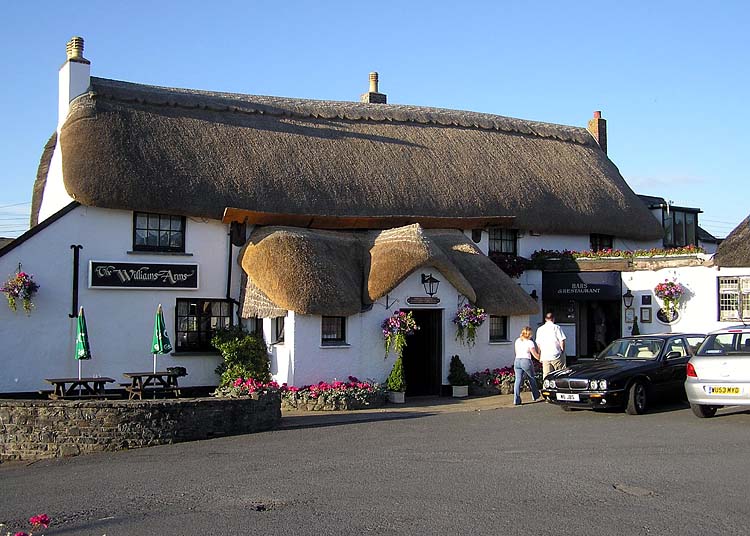
A pub

Pub interiors
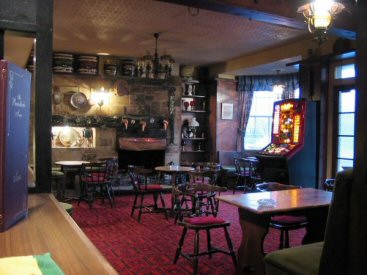
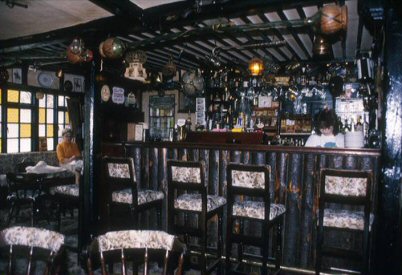
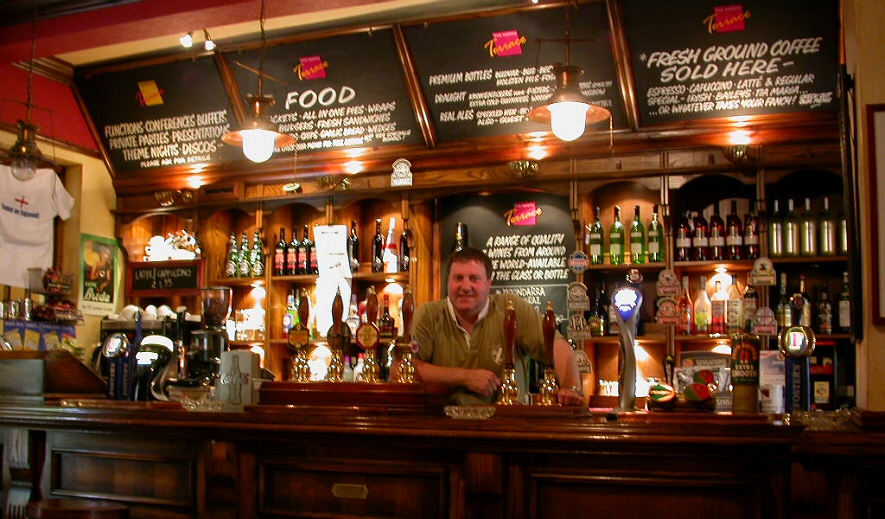
|
Typical features § pubs look old inside and outside (even if newly built)
§
they have small windows to make
the place feel more homey and make it more difficult
to see inside from the outside
§
fairly few lights
(half-light)
§
carpet on the floor
§
plenty of glasses
and/or bottles on the self behind the tender |
'How to close the pub' ceremony Since November 2005 pubs can choose to stay open beyond 11pm, however when the hour of their closing time nears the barman will tipically do one of two things, or both. He will shout 'last orders, please', signalling to the customers that if they mean to have another drink it is the last time they may do so that day, leaving them about 15-20 minutes to drink what they order before the pub definitely closes. Another way to let the clientele of the pub know it is time to be heading home is the ringing of a bell. The barman will shout, 'Ladies and gentlemen, time, please'. |
|
elevenses |
tízórai |
|
afternoon tea |
uzsonna |
|
cod, haddock, plaice |
tőkehal, foltos tőkehal, lepényhal |
|
tacky |
modortalan |
|
cask ale beer, pressurised keg beer |
különböző fajta csapolt sörök |
sources:
100 Questions Answered; Foreign & Commonwealth Office, London
National Statistics, UK 2002, The Official Yearbook of Great Britain and Northern Ireland
Wikipedia
James O'Driscoll: Britain Oxford University Press 1997
Photo of Fish And Chips © Tied House Inc. 2005
Photo of Milk clouds in tea © Xavier Snelgrove 2005
Photo of Pub interior © Károly Pintér 2006
Pubs: extracted from Wikipedia The Free Encyclopedia under GNU Free Documentation Licence.
Description of Afternoon tea © Sofitel St James Hotel 2006
